Saint Charles of Sezze: A Life of Humble Service

On January 7, Franciscans in the United States celebrate not only St. Angela of Foligno [see reflection for January 4] but also join their brothers and sisters elsewhere in recalling the memory of a Friar Minor known for his profound spiritual life: Saint Charles of Sezze (1613–1670).
Born to a devout farming family
He was born Giancarlo Marchioni to a devout farming family of modest means in Sezze, about 40 miles south of Rome. As a young man he helped with tasks on the farm, tending to the livestock and ploughing. His parents hoped he would eventually study for the priesthood, but he was a poor student, so that avenue was closed.

The town of Sezze, Italy, birthplace of Saint Charles
Content with a life of humble service
When he was 20, he fell seriously ill and made a vow to become a Franciscan if he recovered. He joined the Reformed Friars Minor at Nazzano in 1635; his parents continued to press him and his superiors to pursue ordination, but Charles knew his own capacities and was content with a life of humble service.
Devoted to intense prayer, works of charity
Charles was assigned to a number of friaries in the Roman province, working at various jobs: porter, gardener, cook, quaestor (the friar who went out begging for alms), and sacristan. He also devoted himself to intense prayer and works of charity.

Modern image of Saint Charles of Sezze (1969) by Italian artist Antonio Sicurezza (+ 1979), Immaculata Church, Latina, Italy. As depicted in this image, Saint Charles received the stigmata in the form of a single wound on his chest.
Developed powerful insights into people, situations
In practical matters Charles often seemed to be awkward, a “disaster waiting to happen”: once, while cooking, he created a major fire in the friary. On the other hand, he developed a powerful spiritual insight into people and situations.
Sought out for spiritual advice
Once, the guardian of a convent ordered Charles—who was the porter at the time—to give food only to traveling friars who came to the door. He did this in obedience, and alms to the friars decreased. He persuaded the guardian that the two facts were related. When the friars resumed helping all who requested assistance, offerings to the friars increased. Gradually, Charles’s reputation spread; he was sought out for advice by prominent families and high ecclesiastics, including three popes.
Wrote famous spiritual autobiography
Despite his lack of education, Charles began to put his insights into writing. Besides an extensive correspondence, he wrote a number of devotional works, described as “solid, spiritual, and seraphic.” Most famous was his spiritual autobiography, “The Grandeurs of the Mercies of God,” written at the command of his confessor.
Canonized by Pope John XXIII
Charles died at the friary of San Francesco a Ripa in Rome on January 6, 1670. He was beatified in 1882 and canonized by Pope Saint John XXIII in 1959.

The church of San Francesco a Ripa in Trastevere, Rome, where Saint Charles died

The remains of Saint Charles at San Francesco in Rome
Wisdom of Saint Charles of Sezze
God does not command us to live in hair shirts and chains, or to chastise our flesh with scourges, but to love Him above all things and our neighbor as ourselves.
Dominic Monti, OFM
Professor of Franciscan Research in the Franciscan Institute of St. Bonaventure University
Dominic V. Monti, OFM, is a Franciscan Friar of Holy Name Province (USA) and currently professor of Franciscan Research in the Franciscan Institute of St. Bonaventure University. He devoted the greater part of his ministry to teaching the History of Christianity, in particular the history of the Franciscan movement. He has contributed two volumes to the Works of St. Bonaventure series and is author of Francis & His Brothers, a popular history of the Friars Minor.

